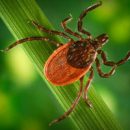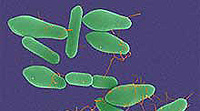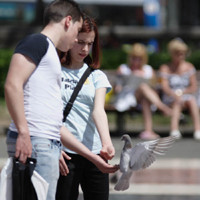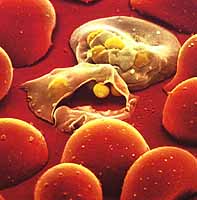History of the plague is rooted in deep antiquity, modern people have forgotten about epidemics who carried out millions of lives. But here is a terrible infection already «costs» At the borders of Russia. The case of death with death is registered in Kyrgyzstan. Refresh memory, remember the plague and its prevention.
Content
Plague — The disease belongs to particularly dangerous infections is under strict UN control. History of the plague was reflected in the myths of the ancient peoples and even in the Bible, as God's Cara for the sins of mankind. Justinianova Plague 551-580 g, epidemic «Black death» In Europe, the XIV century, the London outbreak of the plague took millions of human lives. In Russia, outbreaks were registered in different years, the disease returned repeatedly, and now the plague again on the threshold of Russia.
The culprit of who?
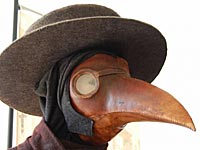 Causative agent of plague — Bacterry Iranii Pestis (Yersinia Pestis), named its discoverer A. Yersen. A microorganism is resistant to cold Russian winters, persists in natural and urban foci of infection. High temperatures are destructively acting on Iracinium, like disinfectants.
Causative agent of plague — Bacterry Iranii Pestis (Yersinia Pestis), named its discoverer A. Yersen. A microorganism is resistant to cold Russian winters, persists in natural and urban foci of infection. High temperatures are destructively acting on Iracinium, like disinfectants.
The microorganism is able to persist in the sputum of the patient up to 10 days, linen and clothing with discharges from bellows or wethers. Weeks remain dangerous to humans.
The carrier of pathogens of the plague are fleas parasitizing on rodents. Flea, heated infected blood of the patient rodent, becomes «Factory» for the production of microbes. Iracinium multiplies so quickly that the plug form («Plague block»), blocking flea esophagus and makes it difficult for her food, bluch joins the plug, having travelers to the plague in the rink, resulting in a bite.
Plague — Rodent disease. Why a person is infected?
In nature, plague fleas live mainly on rodents. In advance of rats of plague, fleas deprive themselves «convenient owners». Rats die out, fleas move on pets and people.
Fleas can starve 6-7 weeks, but more often catering caterpillars and worms. Their unpretentiousness explains the penetration of infection in the city: fleas are clogged into road bags and travel, looking for a new one «owner». Rats are also not afraid of difficulties and distances, traveling in trains and ship, tolerate hundreds of insects.
The man is infected not only as a result of the bite of fleas, but also at contact with the contaminated rodent, its saliva, feces, skirt.
The distribution of infection is possible from a sick plastic to a healthy person. Especially dangerous patients with a pulmonary form of plague, distinguishing pathogens along with the mocroid.
As the disease is manifested?
The incubation period of the plague continues from several hours to 9 days.
The disease begins acutely and accompanied by severe intoxication. In the patient, the temperature of the body sharply increases, the head and muscular pain appears, anxiety is growing, an imperfection appears for man. The face becomes red, eyes «Blood poured», bruises appear under them, the tongue is covered with a white bloom and swells, because of which it becomes insensitive. In severe cases, hallucinations arise, nonsense. The behavior of the patient of the Chuma and its appearance reflects the probation «Plague».
Skin shape of the plague
Hitting the wound, the pathogen of the plague causes local inflammation. Initially, a stain is formed, then a bubble. central part «Plague bubble» filled with black content, it surrounds the raised red zone. In the suppuration of bubbles turn into non-healing ulcers. Skin shape of the plague is rare, usually the disease goes into a bubonic form.
Bubonic plague
The pathogen of the plague travels through the body of the patient, falling into regional lymph nodes. Lymphoid fabric is not able to delay infection, the nodes are inflamed, increase in size and become the place of reproduction of Iersin. On the second day of the disease from an infected lymphatic node, a bubo is formed, pain occurs in its appearance.
More often fleas biting people behind their feet and therefore bubones appear in groin, less often — in the axillary region or neck. Since the distance from the axillary depression and the neck to the lungs is minimal, the infection falls into the lungs — The lung form of plague develops.
What a bubony looks like? Initially, it is just an enlarged and compacted lymphatic node. As inflammation develops, the skin is stretched, blushes, glares, acquires a purple shade. Other lymph nodes and the surrounding tissues are involved in the process, a single conglomerate is formed, not having clear contours.
Pulmonary form of plague
The disease is characterized by inflammation and decay of the pulmonary tissue, the rapid development of respiratory failure and in the absence of treatment, soon fatal outcome.
How to protect yourself from the plague?
Plague — The disease that is successfully treated, Iracinium is sensitive to antibiotics, difficulties occur at the pulmonary form of the disease and late diagnosis. Treatment includes disintellation and local therapy.
History of the plague taught people to defend. The fight against infection is governed by international rules and regulations, Russia's anticipate service is considered one of the most advanced in the world.
All prevention measures can be divided into those are carried out in the foci of infection and those that need to be followed by contact with the patient. Treatment of patients with plates is carried out in isolation subject to strict rules, doctors work in anticipated costumes.
For active prevention, a living anticipated vaccine has been created. Duration of immunity 5 months, then need revaccination.
Vaccinations are subject to those who go to work in the unfavorable region, showing the introduction of vaccine hunters, foresters in contact with wild animals and living in the endemic zone. Vaccine — The best way to prevent plague.


